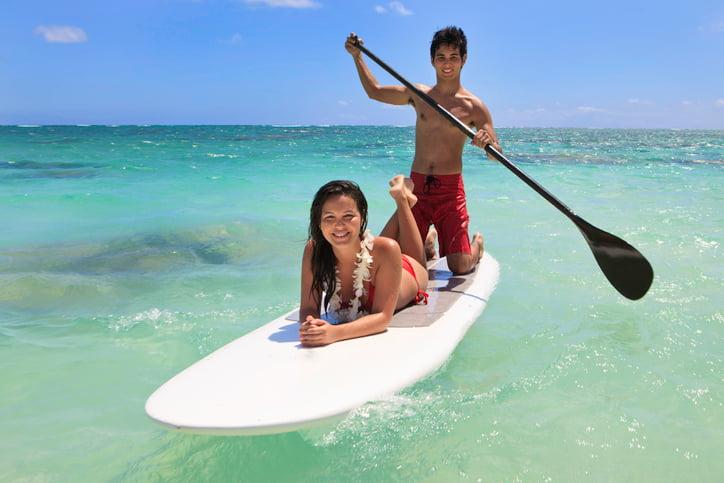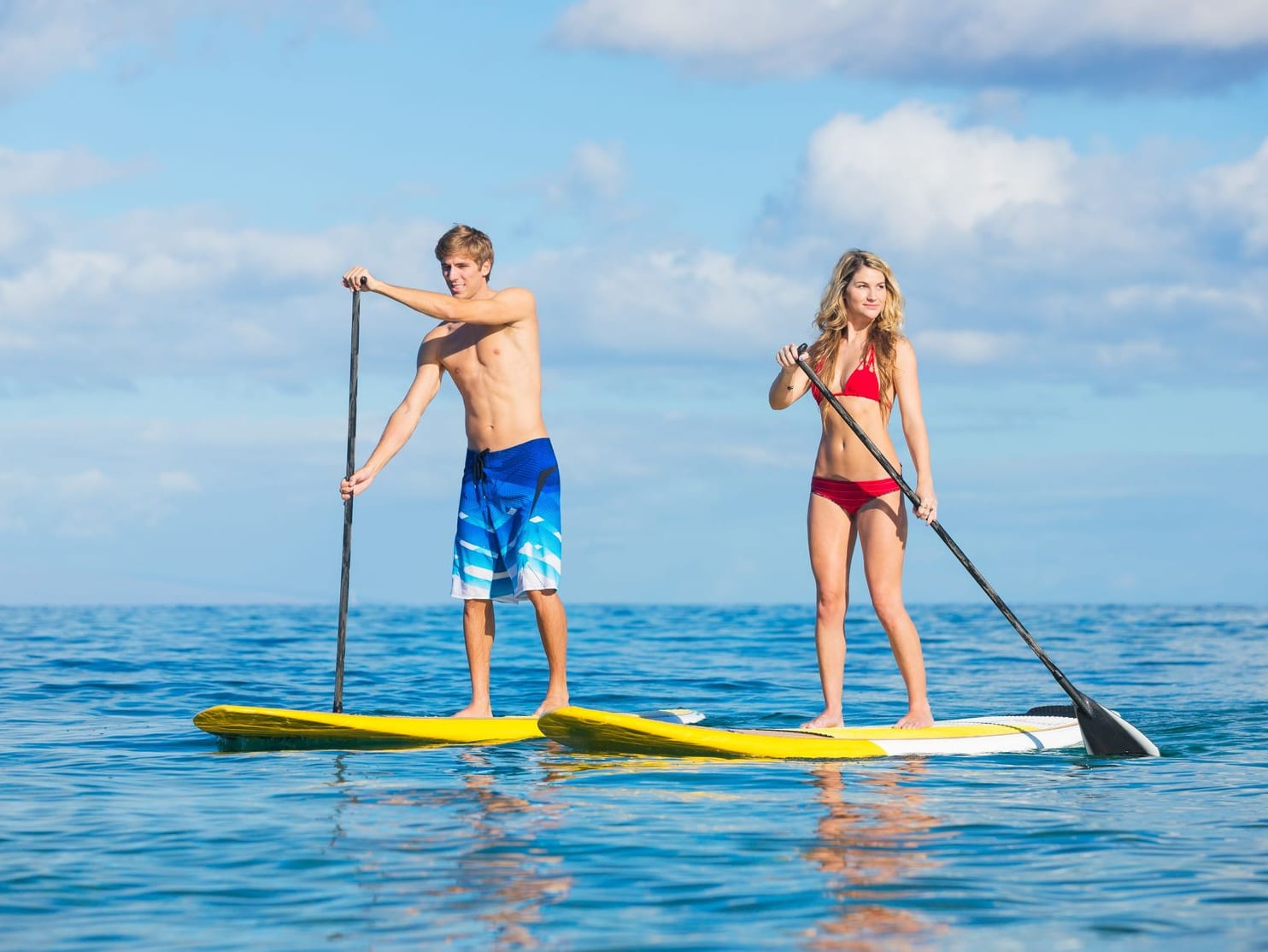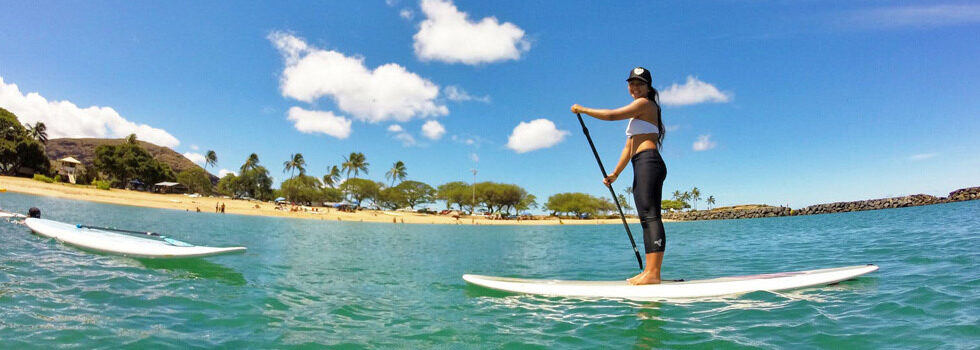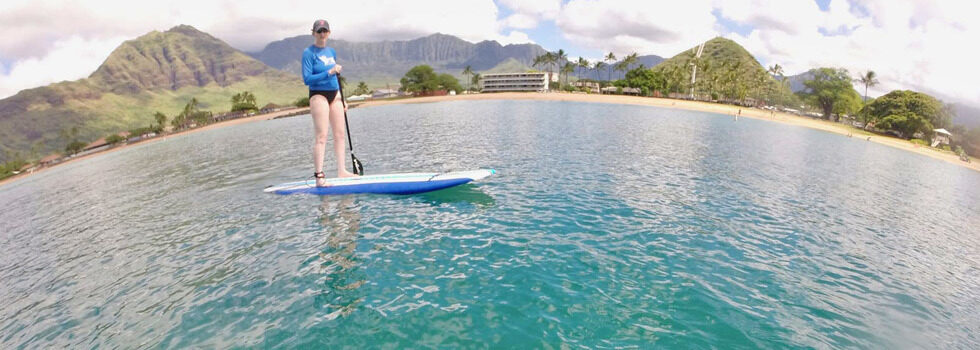If you’ve ever wanted to experience the peacefulness of gliding across the tranquil waters of Hawaii, then learning to paddleboard may be just the activity for you. Whether you’re a beginner or have some previous experience, paddleboarding in Hawaii’s calm waters offers an exciting and accessible way to explore the beautiful coastlines and soak up the island’s natural beauty. In this article, we’ll explore some tips and resources to help you get started on your paddleboarding journey in Hawaii’s idyllic surroundings. So grab your board, leave your worries behind, and let’s learn to paddleboard together in paradise!
Choosing the Right Location
Researching Suitable Spots
When it comes to learning to paddleboard in Hawaii’s calm waters, choosing the right location is essential. The first step is to research suitable spots that offer calm and serene waters, which are perfect for beginners. Look for areas with protected bays or lagoons that are shielded from strong winds and currents. Some popular locations in Hawaii for paddleboarding include Waikiki Beach, Ala Moana Beach Park, and Kailua Bay. These spots are known for their clear and calm waters, making them ideal for beginners to practice their paddleboarding skills.
Consider Local Conditions and Expertise
While researching suitable paddleboarding spots in Hawaii, it’s important to consider the local conditions and expertise available. Look for areas where the water conditions are suitable for beginners, such as gentle waves and minimal currents. Additionally, check if there are any local paddleboarding organizations or schools that offer lessons or guided tours. These experienced instructors can provide valuable insights and ensure your safety while paddleboarding in Hawaii’s calm waters.
Finding Calm Waters
Finding calm waters is crucial for beginners learning to paddleboard. Look for areas that are sheltered from strong winds and currents, as these can make it difficult to maintain balance and control on the board. Protected bays, lagoons, or even inland lakes are excellent options for beginners to practice paddleboarding in Hawaii. These calm waters will provide a stable and safe environment for you to get comfortable with the sport and develop your skills.
Selecting the Right Equipment
Choosing the Right Paddleboard
Selecting the right paddleboard is essential for a successful and enjoyable paddleboarding experience. Consider factors such as your weight, skill level, and intended use of the paddleboard. Beginners should opt for wider and more stable paddleboards, as these offer better stability and balance. Additionally, inflatable paddleboards are a popular choice among beginners as they are lightweight, easy to transport, and provide excellent stability on calm waters. It’s also important to ensure that the paddleboard is the appropriate size for your height and weight, as this will further enhance your overall experience.
Picking the Correct Paddle
Choosing the correct paddle is equally important as selecting the right paddleboard. The paddle should be the right length, lightweight, and comfortable to hold for extended periods. When standing upright with the paddle beside you, the handle should reach your wrist crease. This ensures that you have a proper reach and can exert enough power during your paddle strokes. Additionally, consider the material and design of the paddle to ensure it is durable and provides optimal performance. Most paddleboard rental shops or retailers can assist you in finding the perfect paddle for your needs.
Considering Additional Gear
While paddleboarding in Hawaii’s calm waters, it’s important to consider additional gear that can enhance your safety and overall experience. A leash is an essential accessory that attaches to your ankle and keeps the paddleboard connected to you at all times. This ensures that you don’t lose the board in case you fall off, and it also prevents the board from drifting away. Additionally, wearing a comfortable and well-fitting personal flotation device (PFD) is crucial for your safety, especially if you’re venturing further from the shore. Consider investing in a waterproof bag to store essentials such as sunscreen, water, and snacks during your paddleboarding adventures.

Explore Uncharted Hawaiian Destinations
Learning the Basic Techniques
Understanding Proper Paddle Grip
Before you hit the water, it’s crucial to understand the proper paddle grip, as it affects your control and efficiency while paddleboarding. Hold the paddle with both hands, keeping them shoulder-width apart. Your dominant hand should grip the top of the paddle shaft, while your non-dominant hand should be slightly lower, closer to the blade. Make sure to keep a relaxed grip and avoid gripping the paddle too tightly, as this can cause fatigue and restrict your movements. Practicing the proper paddle grip on land will help you develop muscle memory and ensure a smoother experience once you’re on the water.
Mastering the Basic Stance
Mastering the basic stance is fundamental to maintaining balance and stability while paddleboarding. Begin by positioning yourself in the center of the paddleboard, with your feet hip-width apart. Your knees should be slightly bent to lower your center of gravity and provide better balance. Keep your gaze forward and your back straight, engaging your core muscles to maintain stability. Distribute your weight evenly on the board and avoid leaning too far forward or backward. Practice this basic stance on land to familiarize yourself with the proper body positioning before tackling the waters.
Learning How to Balance and Shift Weight
One of the key skills in paddleboarding is learning how to balance and shift your weight effectively. Start by practicing shifting your weight from side to side while in the basic stance. This will help you get a feel for how your body’s movement affects the stability of the paddleboard. As you progress, experiment with slightly leaning and shifting your weight forward or backward to turn the board. Remember to engage your core muscles to maintain balance and use small, controlled movements to make adjustments. By developing a good sense of balance and mastering weight shifting, you’ll be able to navigate Hawaii’s calm waters with confidence.
Enrolling in a Paddleboarding Lesson
Finding Certified Instructors
When it comes to learning to paddleboard, enrolling in a lesson with certified instructors is highly recommended. Look for accredited paddleboarding schools or instructors who have proper certifications and experience. Certified instructors will have the knowledge and expertise to teach you the correct techniques and safety protocols, ensuring a safe and effective learning experience. They will also be able to provide personalized guidance and answer any questions you may have along the way. By learning from certified instructors, you can build a strong foundation and progress in your paddleboarding skills more efficiently.
Checking Lesson Duration and Pricing
Before enrolling in a paddleboarding lesson, it’s important to check the duration of the lessons and the pricing structure. Lesson duration can vary depending on the school or instructor, ranging from a few hours to multiple days. Consider your schedule and availability when choosing the lesson duration that suits you best. Additionally, compare the pricing of different paddleboarding schools or instructors to ensure you’re getting the best value for your money. While affordability is important, prioritize the quality and reputation of the instructors to make the most out of your learning experience.
Reading Student Reviews
Reading student reviews is a valuable way to gauge the quality and effectiveness of the paddleboarding lessons you’re considering. Look for reviews from past students who have taken lessons from the instructors or schools you’re interested in. Their experiences can provide insights into the teaching style, professionalism, and overall satisfaction of the students. Pay attention to both positive and negative reviews to get a balanced understanding of the instructor’s strengths and weaknesses. Reading student reviews will help you make an informed decision and ensure that you choose a paddleboarding lesson that meets your expectations.

Plan Your Dream Hawaiian Getaway
Preparing for the Lessons
Wearing Proper Attire
Preparing for paddleboarding lessons in Hawaii’s calm waters includes wearing the proper attire. Opt for comfortable swimwear or athletic clothing that allows freedom of movement. Avoid wearing bulky or restrictive clothing that may impede your ability to paddle and maneuver on the board. Additionally, consider wearing a rash guard or sunscreen-protective clothing to shield your skin from the sun’s harmful UV rays. Don’t forget to bring a hat or a visor to protect your face from direct sunlight. By choosing appropriate attire, you’ll be comfortable, protected, and ready to take on the paddleboarding lessons.
Applying Sunscreen and Hydration
As you prepare for paddleboarding lessons, it’s crucial to prioritize sunscreen application and hydration. Hawaii’s sunny climate can lead to sunburn and dehydration, so it’s important to protect yourself. Apply a waterproof sunscreen with a high SPF before heading out onto the water, and reapply regularly to maintain protection. Consider investing in a waterproof sunscreen specifically designed for water activities to ensure long-lasting coverage. Additionally, bring plenty of water to stay hydrated throughout your lesson. Paddleboarding can be physically demanding, and staying hydrated is essential for optimal performance and safety.
Bringing Necessary Equipment
Before heading to your paddleboarding lessons, make sure you have all the necessary equipment with you. This includes your paddleboard, paddle, leash, and any additional gear required. If you’re renting the equipment, ensure that you have made the necessary arrangements in advance to avoid any last-minute surprises. Double-check that your paddleboard is inflated and in good condition, and that your paddle is the correct length and properly assembled. It’s also a good idea to bring a waterproof bag or dry bag to store your personal items, such as your phone, wallet, and keys, while you’re on the water. Being prepared with the right equipment will set you up for a smooth and enjoyable paddleboarding lesson in Hawaii’s calm waters.
Understanding Safety Precautions
Wearing a PFD (Personal Flotation Device)
Safety should always be a top priority when paddleboarding, and wearing a personal flotation device (PFD) is one of the most important safety precautions to take. A PFD is designed to float and keep you buoyant in case you fall off your paddleboard. It’s crucial to wear a PFD, especially when venturing further from the shore or in areas with deeper waters. Choose a PFD that is specifically designed for paddleboarding or water sports, as they are more comfortable and allow for better freedom of movement. Ensure that the PFD fits properly and is securely fastened before getting on the water.
Being Aware of Weather Conditions
Being aware of weather conditions is essential when paddleboarding, as it directly affects your safety and overall experience. Keep an eye on weather forecasts and pay attention to any changes in weather patterns while you’re on the water. Avoid paddleboarding in Hawaii’s calm waters if there are strong winds, thunderstorms, or other adverse weather conditions. It’s important to prioritize your safety and choose to paddleboard on days with favorable weather. Familiarize yourself with the signs of changing weather conditions, such as darkening skies, increasing winds, or sudden drops in temperature, and be prepared to return to shore if conditions deteriorate.
Knowing How to Handle Potential Hazards
While paddleboarding in Hawaii’s calm waters, it’s important to be aware of and know how to handle potential hazards. These can include underwater currents, rocks, reefs, or marine wildlife. Educate yourself about the specific hazards in the area where you’ll be paddleboarding and learn how to navigate or avoid them. If you encounter a strong current or find yourself drifting towards a hazard, remain calm and use your paddle to maneuver away from danger. It’s also advisable to paddle with a buddy or inform someone about your paddleboarding plans, especially if you’re exploring new areas. By being prepared and knowledgeable about potential hazards, you can minimize risks and enjoy a safe paddleboarding experience.

Experience Hawaii’s Unique Attractions
Practicing On Land
Starting on a Stable Surface
Before venturing onto the water, it’s beneficial to practice some paddleboarding techniques on land. Find a stable and flat surface to simulate the feeling of being on a paddleboard. Stand beside the paddleboard and practice your paddle grip, paddle strokes, and balance. Practice shifting your weight from side to side and maintaining the basic stance. This allows you to familiarize yourself with the movements and build muscle memory before getting on the water. Practicing on land also gives you an opportunity to fine-tune your techniques and gain confidence before transitioning to the real deal.
Practicing Paddle Techniques
Practicing paddle techniques on land is an effective way to improve your skills and coordination before stepping onto the water. Start by mimicking the paddle strokes you’ll use while paddleboarding, focusing on proper form and technique. Practice both forward strokes and backward strokes, ensuring that you engage your core and use the correct muscles to avoid strain and fatigue. Additionally, practice turning the paddleboard by using sweep strokes or pivot turns. By practicing these techniques on land, you’ll develop muscle memory and be better equipped to execute them on the water.
Performing Basic Exercises
Performing basic exercises can significantly enhance your paddleboarding experience and overall fitness. Incorporate exercises that target your balance, strength, and core stability. Balancing exercises such as standing on one leg or using a balance board will help improve your stability on the paddleboard. Strengthening exercises such as squats, lunges, and planks will build the necessary muscles and endurance for paddleboarding. Additionally, focus on exercises that engage your core, such as Russian twists or side planks, as a strong core is essential for maintaining balance and stability on the water. Include these basic exercises in your routine to complement your paddleboarding training and enhance your overall performance.
Getting on the Water
Launching Safely
When you’re ready to take your paddleboarding skills to the water, it’s important to launch safely. Find a suitable spot with easy access to the water, such as a sandy beach or a designated launch area. Make sure there are no obstacles or hazards in your immediate vicinity. Gently place your paddleboard in the water, ensuring that the fin is facing downwards. Hold onto the board or secure it with the leash to prevent it from drifting away. With both hands on the paddle, step onto the board one foot at a time, ensuring even weight distribution. Once you feel stable, push off from the shore and begin your paddleboarding adventure.
Finding the Right Position on the Board
Finding the right position on the board is crucial for maintaining balance and stability while paddleboarding. Stand in the center of the board with your feet hip-width apart, ensuring that your weight is evenly distributed. Avoid standing too far forward or backward, as this can affect the stability of the board. Keep your gaze forward and your back straight, engaging your core muscles for balance. Experiment with small adjustments in weight distribution to fine-tune your position on the board. Finding the right position will ensure a comfortable and controlled paddleboarding experience on Hawaii’s calm waters.
Paddling Techniques for Calm Waters
Once you’re on the water, it’s time to master the paddle strokes and techniques for navigating Hawaii’s calm waters. Start with the basic forward stroke, where you dip the blade of the paddle into the water near the front of the board, and then pull it back past your ankle to propel yourself forward. Engage your core and use your torso muscles to generate power, rather than relying solely on your arms. To turn, use sweep strokes on one side of the board, extending the paddle out and away from the board while maintaining a fluid motion. Practice these techniques in coordination with your balance and weight shifting skills to navigate Hawaii’s calm waters with ease and grace.

Improving Balance and Stability
Using Proper Paddling Technique for Stability
Using a proper paddling technique can significantly enhance your balance and stability on the paddleboard. Engaging your core muscles and using a fluid, full-body motion will help you stay balanced and steady. Avoid putting excessive strain on your arms or relying solely on them for paddling. Instead, use your core, back, and leg muscles to generate power and maintain stability. Focus on keeping your upper body relaxed, as tension can affect your balance. By using a proper paddling technique and incorporating your entire body, you’ll improve your balance and stability on Hawaii’s calm waters.
Utilizing Core Strength
Core strength plays a vital role in maintaining balance and stability while paddleboarding. Your core muscles act as a stabilizer and help you maintain proper posture and control on the board. Incorporate exercises that target your core, such as sit-ups, planks, or yoga poses like boat pose or downward dog. Strengthening your core will not only improve your balance and stability on the paddleboard but also enhance your overall paddling performance. Focus on performing these exercises regularly to build a strong core and improve your stability on Hawaii’s calm waters.
Practicing Balance Exercises
Practicing balance exercises off the paddleboard can greatly improve your stability and control while on the water. Incorporate exercises such as single-leg stands, yoga balance poses, or using a balance board or stability ball. These exercises challenge your balance and simulate the dynamic movements you’ll encounter while paddleboarding. By performing these exercises consistently, you’ll develop better proprioception, body awareness, and muscle coordination, leading to improved balance and stability. Incorporate balance exercises into your paddleboarding training routine to maximize your performance and enjoyment on Hawaii’s calm waters.
Enjoying the Experience
Taking in the Scenic Views
One of the most enjoyable aspects of paddleboarding in Hawaii’s calm waters is the opportunity to take in the scenic views. As you paddle along, take a moment to appreciate the natural beauty around you. Enjoy the breathtaking shoreline, the crystal-clear waters, and the vibrant marine life beneath you. Hawaii offers a wide range of stunning scenery, from lush tropical landscapes to picturesque sunsets. Soak in the tranquility and embrace the serenity of the moment. Take breaks during your paddleboarding sessions to simply float on the calm waters and appreciate the awe-inspiring views that make Hawaii a truly special paddleboarding destination.
Exploring Hidden Spots
Paddleboarding in Hawaii’s calm waters opens up opportunities to explore hidden spots that may not be accessible by other means. Take advantage of your paddleboard’s versatility and maneuverability to discover secluded coves, hidden beaches, or shallow reefs. These hidden spots often offer pristine beauty and a sense of tranquility that can only be experienced by paddleboarding. Embark on mini-adventures and paddle into uncharted areas, guided by your sense of curiosity and adventure. Just be mindful of the local regulations and respect the environment as you explore these hidden gems.
Engaging in Other Water Activities
Paddleboarding is just the beginning of the water activities you can enjoy in Hawaii’s calm waters. Take advantage of your time on the water to engage in other activities such as snorkeling, swimming, or even yoga on the paddleboard. Hawaii’s warm waters and rich marine life make it an ideal destination for snorkeling enthusiasts. Explore the vibrant coral reefs and swim among tropical fish as you immerse yourself in the underwater world. If you’re feeling adventurous, try practicing yoga poses on your paddleboard for a unique and zen experience. Embrace the versatility of paddleboarding and make the most of your time in Hawaii’s calm waters by engaging in a variety of water activities.
In conclusion, learning to paddleboard in Hawaii’s calm waters can be an exhilarating and rewarding experience. By choosing the right location, selecting the right equipment, and enrolling in a paddleboarding lesson, you’ll be well on your way to mastering this popular watersport. Remember to prioritize safety by wearing proper attire, applying sunscreen, and familiarizing yourself with safety precautions. With practice and perseverance, you’ll improve your balance, stability, and paddling techniques, allowing you to fully enjoy the beautiful scenic views and engage in other water activities. So, gear up, embrace the adventure, and paddleboard your way to an unforgettable experience in Hawaii’s calm waters.
